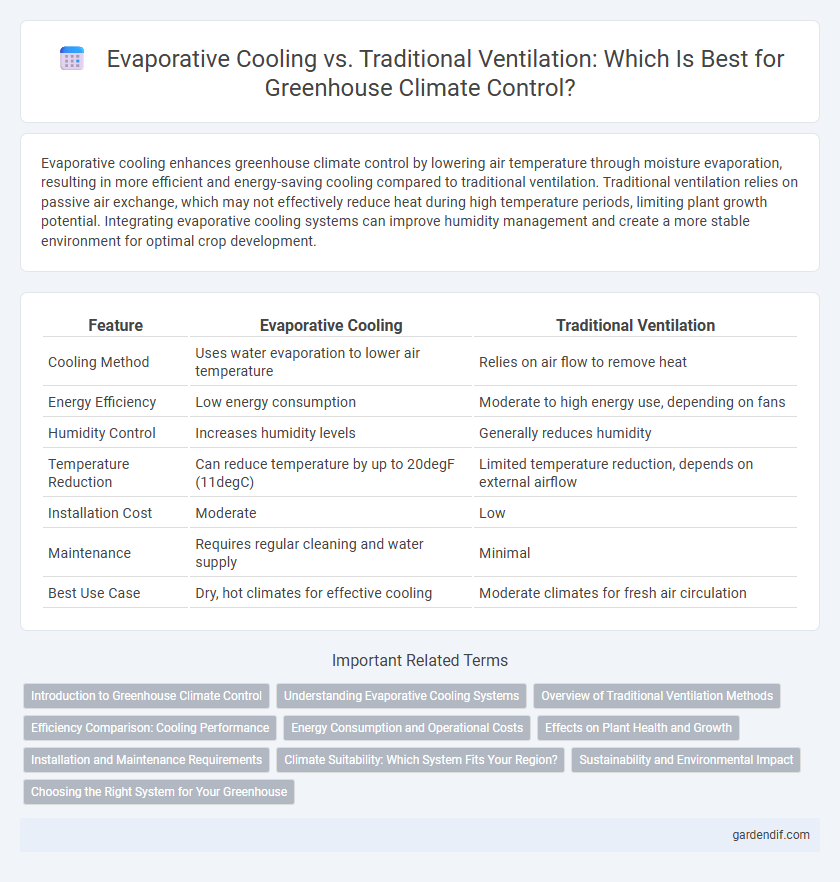
Evaporative Cooling vs Traditional Ventilation Illustration
Evaporative cooling enhances greenhouse climate control by lowering air temperature through moisture evaporation, resulting in more efficient and energy-saving cooling compared to traditional ventilation. Traditional ventilation relies on passive air exchange, which may not effectively reduce heat during high temperature periods, limiting plant growth potential. Integrating evaporative cooling systems can improve humidity management and create a more stable environment for optimal crop development.
Table of Comparison
| Feature | Evaporative Cooling | Traditional Ventilation |
|---|---|---|
| Cooling Method | Uses water evaporation to lower air temperature | Relies on air flow to remove heat |
| Energy Efficiency | Low energy consumption | Moderate to high energy use, depending on fans |
| Humidity Control | Increases humidity levels | Generally reduces humidity |
| Temperature Reduction | Can reduce temperature by up to 20degF (11degC) | Limited temperature reduction, depends on external airflow |
| Installation Cost | Moderate | Low |
| Maintenance | Requires regular cleaning and water supply | Minimal |
| Best Use Case | Dry, hot climates for effective cooling | Moderate climates for fresh air circulation |
Introduction to Greenhouse Climate Control
Evaporative cooling in greenhouses utilizes the process of water evaporation to lower the air temperature and increase humidity, creating a more controlled microclimate for plant growth. Traditional ventilation relies on passive airflow through vents or fans, which can be less effective in hot, dry conditions due to limited cooling capacity and lower humidity control. Combining evaporative cooling with proper ventilation enhances temperature regulation and humidity balance, optimizing greenhouse climate control for improved crop productivity.
Understanding Evaporative Cooling Systems
Evaporative cooling systems in greenhouses utilize the natural process of water evaporation to lower air temperature and increase humidity, promoting optimal plant growth. Unlike traditional ventilation which relies on air exchange to reduce heat, evaporative coolers actively cool incoming air, providing energy-efficient climate control. Key components include wetted pads, a water supply, and fans that draw air through the pads, making these systems particularly effective in hot, dry environments.
Overview of Traditional Ventilation Methods
Traditional ventilation methods in greenhouses primarily involve natural ventilation through roof vents, sidewalls, and louvers that facilitate airflow by utilizing wind pressure and thermal buoyancy. These systems rely on passive air exchange to reduce temperature and humidity, often resulting in less precise climate control compared to mechanical options. While cost-effective and energy-efficient, traditional ventilation may struggle to maintain optimal growing conditions during extreme weather or high-density cropping.
Efficiency Comparison: Cooling Performance
Evaporative cooling systems in greenhouses offer superior efficiency by reducing air temperature through water evaporation, which can lower temperatures by up to 15degF more than traditional ventilation methods. Traditional ventilation relies on passive airflow and can be less effective in high humidity or stagnant air conditions, limiting its cooling performance. Evaporative cooling also enhances humidity control and energy savings, making it a more efficient choice for maintaining optimal growing conditions.
Energy Consumption and Operational Costs
Evaporative cooling systems in greenhouses use up to 70% less energy compared to traditional ventilation methods, significantly reducing operational costs. While traditional ventilation relies on high-powered fans and natural airflow, evaporative cooling leverages water evaporation to lower temperatures more efficiently, resulting in lower electricity consumption. This energy-efficient approach not only decreases utility bills but also enhances sustainable greenhouse management.
Effects on Plant Health and Growth
Evaporative cooling in greenhouses maintains optimal humidity and temperature levels, reducing plant stress and enhancing photosynthesis efficiency compared to traditional ventilation. This method promotes faster growth rates and healthier foliage by providing consistent microclimate control and minimizing temperature fluctuations. In contrast, traditional ventilation often leads to uneven airflow and temperature variations, which can increase the risk of diseases and stunt plant development.
Installation and Maintenance Requirements
Evaporative cooling systems in greenhouses require specialized installation involving water lines, pads, and fans, whereas traditional ventilation relies mainly on vents, louvers, or exhaust fans that are simpler to install. Maintenance for evaporative cooling involves regular cleaning of pads and water systems to prevent mineral buildup and ensure efficient cooling, while traditional ventilation demands less frequent upkeep, primarily checking vents and fans for obstructions or mechanical issues. Choosing between the two depends on balancing initial installation complexity and ongoing maintenance needs to optimize greenhouse climate control.
Climate Suitability: Which System Fits Your Region?
Evaporative cooling performs best in hot, dry climates by efficiently lowering air temperature through moisture evaporation, making it ideal for arid regions with low humidity. Traditional ventilation suits temperate and humid climates by promoting air exchange and reducing heat without adding moisture, preventing humidity-related issues in enclosed greenhouse environments. Selecting the appropriate system depends on local temperature, humidity levels, and greenhouse crop requirements for optimal climate control.
Sustainability and Environmental Impact
Evaporative cooling in greenhouses reduces energy consumption by utilizing water evaporation to lower temperatures, making it a sustainable alternative to traditional ventilation systems that rely heavily on electric fans. This method minimizes carbon emissions and water usage compared to conventional cooling, which often results in higher greenhouse gas outputs and increased resource depletion. Implementing evaporative cooling supports eco-friendly agriculture by enhancing energy efficiency and reducing the carbon footprint of greenhouse operations.
Choosing the Right System for Your Greenhouse
Evaporative cooling systems maintain optimal humidity levels and lower temperatures efficiently by circulating moist air, making them ideal for hot, dry climates in greenhouse environments. Traditional ventilation relies on natural airflow through vents and fans, suitable for moderate climates but less effective in extreme heat or high humidity. Selecting the right system depends on your greenhouse's climate conditions, crop requirements, and energy efficiency goals.
Evaporative Cooling vs Traditional Ventilation Infographic

 gardendif.com
gardendif.com